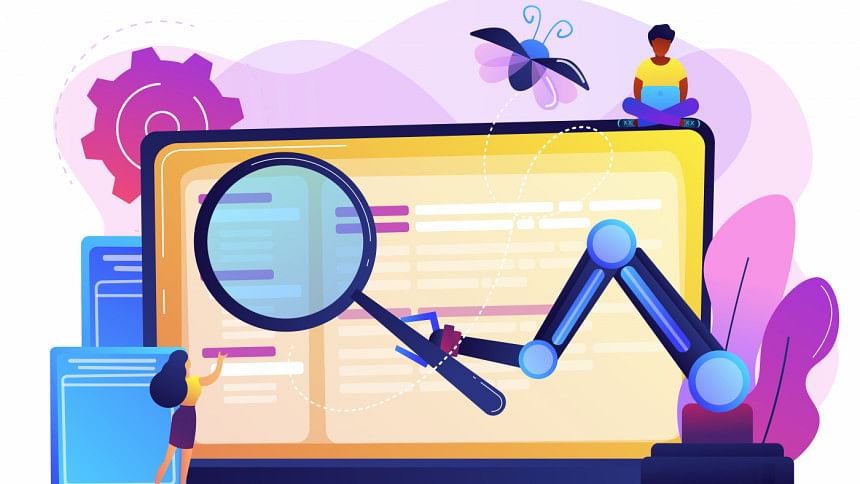Ushering AI in Bangladesh

In 2019, Bangladesh, a nation with millennia-long history in farming, crossed a remarkable milestone: it achieved self-reliance in rice production. The International Rice Research Institute (IRRI) proudly mentioned on its website how this country rose from a food deficit beginning in 1971, when its annual production was a paltry 15 million tonnes, to a staggering 54 million in 2019 – that, too, with a declining land available for farming due to ever-increasing urbanisation. IRRI correctly pointed out that such a spectacular progress was possible largely due to the improvement in the genetic potential of rice varieties through breeding, availability of climate-smart rice varieties, improved management practices and facilities, and government policy support.
The other crucial contributing factor to this growth is certainly the ever-optimistic farmers of the Bengal delta, an archetype of which we see in Sultan's paintings. The other important role was played by the nation's scientific community, including Bangladesh Agriculture University (BAU), Bangladesh Rice Research Institute (BRRI), Bangladesh Institute of Nuclear Agriculture (BINA), Department of Agricultural Extension (DAE), Bangladesh Agricultural Research Council (BARC), and many other such organisations. Their researchers worked tirelessly with a strong conviction for years on end to develop better rice varieties that would be tolerant to drought, flood, salinity, and pests, and be economical to grow and farmer-friendly. All these together made possible such a spectacular stride.
The story doesn't end there. Bangladesh is among the top in the production of freshwater fish, vegetables, potato, and fruits too, despite having a much lesser amount of land than the others. Similar to rice production, these were made possible through the combined efforts of growers and scientists, together with generous policy support.
However, sustaining such a growth poses a significant challenge. BRRI, which has so far commercialised over 100 rice varieties, has found that it takes 15-16 years to develop a new variety and another three for field testing. But their growth potential and other desirable properties start declining within 10 years, keeping the scientists ever on the search for even better ones. This is a never-ending race that only gets faster with time.
But research work is arduous, painstaking and long. A significant amount of time and effort goes into reviewing what is already known in the scientific community by going through the large volume of published work. And with time, the volume of such work is increasing almost on a logarithmic scale. Worldwide, a new research paper is published every 30 seconds, making it one million each year. A search on any single topic, such as the tumour suppressor p53, will find a staggering 70,000 published papers, as a World Economic Forum (WEF) blog post states. Access to reliable knowledge and the academic literature has become a fundamental bottleneck for the scientific community, policymakers, and business people. It is one of the reasons why it takes much longer to win a Nobel Prize for a scientist after publishing the work, as Nature, a prestigious scientific journal, has mentioned. A 2022 article titled "The Nobel Prize Time Gap" reported that, between 1901 and 2019, the time span from publishing a paper to actually winning a Nobel Prize continuously got longer. Only in 25 percent of the cases, the winners were recognised within 10 years of publication; the rest had to wait at least 10 and in many cases more than 20 years. But in 2011-2019, the delay ranged from 26 (medicine) to 31 years (economics). The authors have found various reasons for this phenomenon, one of which is the large number of works that must be reviewed before a winner is chosen. Humans alone simply cannot do that and, quite naturally, scientists are resorting to tools powered by artificial intelligence to search and analyse such documents.
Last year, another article in Nature cited an example from the University of Gothenburg in Sweden, where a team researching on self-driving vehicle algorithms found more than 10,000 papers to be reviewed. It would have taken over a year to review them, involving hundreds of person-hours. Luckily, AI-powered tools were already available to them, which offered a "quick and precise overview of what should be relevant to a certain research question," as the article quoted the team. Only an AI-powered search tool can offer such targeted navigation of the knowledge landscape, enabling a scientist to save years from mundane tasks for better utilisation in higher value-added scientific endeavours.
Bangladesh stands at the threshold of a paradigm shift in technological development as it is poised to change gear into a faster mode of economic development, and realising its vision of becoming a developed nation by 2041. But will it be possible without making use of the modern tools in science and technology?
The answer is only too obvious. Following the global standard and to achieve their research goals, scientists in Bangladesh have already started using such AI-powered computational readers and scientific knowledge miners. Recently, the Bangladesh University of Engineering and Technology (Buet) pioneered in this arena by offering such AI software to its researchers, teachers and students to speed up its research activities. This is what it takes to lead the nation in the age of digital technology.
Dr Sayeed Ahmed is a consulting engineer and the CEO of Bayside Analytix, a technology-focused strategy and management consulting organisation.

 For all latest news, follow The Daily Star's Google News channel.
For all latest news, follow The Daily Star's Google News channel. 








Comments